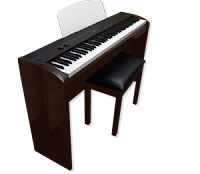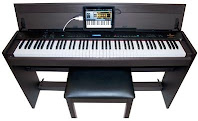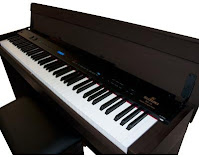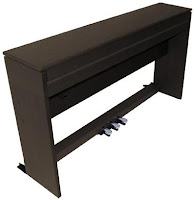UPDATED REVIEW – November 3, 2013 – Suzuki SD10 & SL1 Digital Piano – READ THIS BEFORE YOU BUY – *For the new DG10 Micro Grand Digital Piano Review go to the following link: Suzuki DG10 Micro Grand REVIEW.
I have never liked Suzuki digital pianos in the past based on all my experience with them (and I have a lot of experience over the years) because they were always pretty bad in reproducing a good acoustic piano tone and piano key action with proper tonal dynamics and response and limited pedaling, and I have played and reviewed many of them. Although the name Suzuki is somewhat famous with regard to music education (violin, piano) & vehicles (cars, motorcycles, etc), the Suzuki “piano company” is a completely separate entity and has no connection with the original Suzuki company other than being able to use the name. The Suzuki piano company is actually an importer of digital & acoustic pianos & other musical instruments from third party Chinese manufacturers which are lesser quality, lower priced pianos available at Costco in the US for resale to the public. Suzuki has little to do with the production and design of the pianos under that name unlike the better names who actually design, produce, and manufacture their own digital pianos such as Kawai, Roland, Casio, and Yamaha.
The Suzuki SD10 ($799 internet discount price) and its more basic little brother the SL1 ($599 Costco internet price) are inexpensive models sold primarily through Costco as I just mentioned. Suzuki also calls the SD10 an ‘upright piano’ but that is just a marketing term and in reality it is far from being an “upright piano”…but it’s a cute name nevertheless. A real acoustic upright piano stands about 48″ tall. The Suzuki SD10 stands at about 30” tall…a big difference! Costco has offered many different Suzuki digital pianos in the past which were, in my opinion, all undesirable instruments in a variety of ways except they generally looked attractive. However, the SD10 is definitely an improvement over those past models in both key action, piano sounds, & features, but they are still lacking in some important ways which I will talk about further down in this review. I would recommend the SD10 piano if there were no other better digital piano brands & models available in the lower price range, but there are others including the Yamaha P105 ($599 internet price), Kawai ES100 ($799 internet price), Casio PX750 ($799 internet price) and Casio PX780 ($999 internet price) which I consider a “best buy.” I would definitely recommend those pianos over the SD10 & SL1…and over the DG10 micro grand.
The SD10 is in a fairly attractive (as most Suzuki pianos are), functional furniture type compact case with a slow closing key cover top which folds flat (left pic) which is pretty cool, and I happen to like that. But other than it having a flat fold over lid with music rack attached, the piano itself is physically not much different than the Yamaha’s and Casio’s when they are connected to their furniture stands and 3 pedal units. The Suzuki SD10 comes with the stand and 3-pedal unit along with a small matching bench, so everything is included at the $799 price. The other brands are better, but the stands, pedals, and benches are sometimes optional and add to the price. The control panel on the SD10 is easy to use, fairly intuitive and their are a number of features such as sound layering, sound splitting, duet play, 2 track MIDI recording, reverb, a handy adjustable digital metronome for timing, an EQ control panel knob for changing the sound from mellow to brighter (not usable when listening through headphones), and a nice backlit LCD user display screen to show what’s going on in the piano when you select different buttons and functions. So all and all it’s a pretty nice instrument when it comes to features.
The piano has 8 panel instrument sound buttons with a variation button which makes for a total of 16 instrument sounds that light up and are easily accessed from the control panel, plus you can get many more instrument sounds when you go into the digital menu. The SD10 also has a General MIDI playback song function when songs are loaded into the piano via a USB flash drive. In this way you can play along with songs in the General MIDI format to better learn to play them. I have written some blog reviews on General MIDI and why it can be an fun advantage to have that feature.
The SD10 has a fairly powerful stereo speaker system for its size with 30 watts of total power and the two 5″ speakers it has are not on the top but instead underneath the piano facing forward (left pic). This is OK but having the speakers on top of the piano and then additional speakers facing down or out would have been better because that’s the way acoustic pianos work having the sound project upward (on grands) and/or nearer to your ears instead of just away from you below your waste. The pedals seem to work fine in duplicating the basic function of piano pedals, although it does not duplicate the graduated half pedal function (such as what the Yamaha & Casio digital pianos have) which allows for more gradual pedal sustain you would get on traditional acoustic pianos. But at $799 for an instrument like this, that’s not surprising. The piano has 2 headphone jacks for private playing, an audio input jack, audio output jack, a USB MIDI output connection to computer or iPad which is a very cool thing to have to interface with those external devices, and also separate MIDI connections for other uses.
So from the looks of it, this Suzuki SD10 seems to be a good buy, but the piano key action and piano sound is what’s most important and that is where this model has some trouble, in my opinion. Although both the piano sound reproduction and key action are improved from past models, they still fall quite short of where they need to be and where the competition is. When you play an actual acoustic piano, there are many things that need to happen to make the piano play and sound right. The piano sound needs to be balanced and consistent in volume and tone when playing one key to the next, the piano sound dynamics need to be smooth and not jumpy, and the piano needs to obviously ‘sound’ like a piano which is a complex process and requires a lot of dedicated computer memory and high quality piano sample recordings used in digital pianos.
In the SD10, the main ‘grand piano sound’ does not sound like a grand or even any real acoustic piano of any size. The sound is quite muffled and has a synthesizer-like tone to it, especially when you play in the upper octave keys of the piano. It just doesn’t sound right and there is little you can do to change it. There is a second acoustic piano sound called ‘bright piano.’ It is a much better acoustic piano reproduction than the first ‘grand piano’ tone but it is somewhat bright in its tone (hence the name bright). You can use the brightness tone control knob on the panel to mellow it out a little bit but the piano sound is not very rich or full and still has a thinner sound. Also, the control tone knob does not have an effect on the sound when using headphones so there is no way to do any changes at that point. Even though the pianos sounds on this model are actually better than past models, they still have a ways to go to catch up to Yamaha & Casio.
As for the key action, Suzuki says it has “an authentic grand piano feel.” That is one of the most ridiculous statements I have ever heard a digital piano manufacturer make before, especially on this kind of a low priced instrument…and I’ve heard a lot of exaggerated statements before:) Oh well, maybe they think most piano shoppers are gullible? But for the unsuspecting shopper, you may think just because they say it somehow it must be true. Take my word for it, it is definitely not a grand piano key action or even an upright piano key action for that matter. However the feel of the key movement itself is actually pretty good and balanced for a lower price digital piano, although when when you apply harder pressure to the keys when trying to get more dynamic range, when the keys themselves hit the bottom of the ‘keybed,’ they make quite a bit of knocking noise like two pieces of wood hitting each other. The keys are also somewhat noisy when coming back up to their resting position after being pressed down, especially when playing quick staccato notes. This is distracting when playing your music, especially when using headphones because then you can really hear that noise throughout the room or house when someone else is playing it, and its kind of annoying. There are other digital pianos that have similar problems including the newer Roland RP301 & F120 digital pianos which I have also reviewed. If you play the keys softly you don’t have that issue, but when you play more forcefully which is required on many songs, then you do.
 |
| Suzuki SL1 |
The Suzuki SD10 (and SL1) does have a few different key sensitivity changes you can select from and this can help with making the piano playing sound a bit smoother, but it does not drastically improve dynamic range or volume smoothness in this piano and there is definitely noticeable unevenness from one note to the next on various octaves when playing the piano sounds. Although this model only has 64 notes of polyphony memory, it still does a pretty good job with tone decay time and overall playability, but 128 notes (like its competitors) would have been better. More polyphony memory is useful and needed if the student or player wants to be or is at medium to higher skill levels where the music starts becoming a bit more complex. Also, more polyphony memory helps with getting a more realistic pedaling experience as well as allows for better MIDI song playback and sound layering. So the more polyphony you get in the piano, the better. It’s like computer or hard drive memory, the more, the better. But in the beginning stages, 64 notes of polyphony memory is usually sufficient although as the student progresses they will grow out of that piano.
 |
| Suzuki SD10 connected to iPad |
The Suzuki SD10 is at a low price and has a nice closing key cover along with a stronger internal sound system than others. However in trying to reproduce a real acoustic piano, it is still far behind the new Casio & Yamaha digital piano available now. The Yamaha & Casio pianos do cost slightly more money with bench, but in the long run I believe it’s absolutely worth the difference if your goal is to play piano correctly and really enjoy it with out having to compensate and compromise your music…and no one really wants to do that if they can help it.
| Casio PX750 |
The four new pianos I do recommend in the lower price range are the portable Yamaha P105 ($599 internet price), the portable Casio PX150 ($499 internet price), the portable Casio PX350 ($799 internet price), Kawai ES100 ($799 internet price), and the full size PX750 ($799) and the Casio PX780 ($999) which I consider the best buy of all and well worth the extra money. They are by far the most superior models and have the realistic key action and piano sound that people (and piano teachers like me) want and need along with many new, and very cool digital features not found on most portable or compact digital pianos under $1000. Also, like the Suzuki, both the Yamaha & Casio are USB midi compliant and can connect to an iPad or laptop computer for interactive playing and learning (which has become more common to do) now that the iPad has especially become such an integral part of music education, playing, and learning for younger children and adults alike. Here are the links to my reviews of these new piano models:
Yamaha P105 Review
Casio PX150/350 Review
Casio PX750 Review
Casio PX780 Review
Kawai ES100 review
So before you purchase one of these Suzuki’s at Costco or any of the other brands there including Adagio and the Roland digital pianos RP301 & F120, please read my blog reviews on these models to get more info which will help you make a more educated decision. If you think you like the Suzuki SD10 or SL1 and it’s in the right price range for you, then you should buy it. But if you don’t know much about pianos, then I would encourage you to read about the new Casio’s & Yamaha’s which are not only noticeably better as I mentioned earlier, but also will have a higher resale value and be something you can grow into and keep for a longer period of time. At the end of the day, what people really want is a good, durable instrument that will duplicate the best acoustic piano sound & key action possible in the price range you want to be in along with a few other useful digital features. Please let me know if you have any questions.
If you want more info on these and other pianos and lower prices than internet or store discounts, please email me at tim@azpianowholesale.com or call me direct at 602-571-1864
















nice